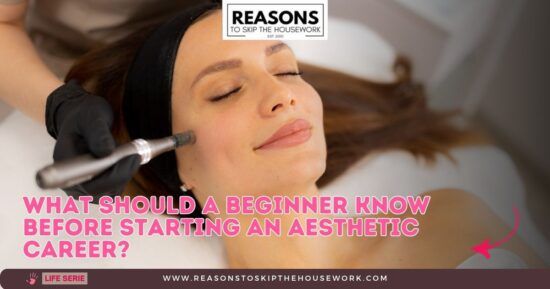Entering the aesthetics industry can feel like stepping into a glamorous world—flawless skin, luxury treatments, and a growing clientele all eager to look and feel their best. But for those considering it as a career, the reality involves far more than beauty buzzwords or trending Instagram filters. Beneath the surface lies a discipline that demands both technical skill and emotional intelligence, not to mention a fair bit of regulatory awareness. It’s not a leap into the unknown, exactly, but it is a shift into a highly specialised, hands-on field where first impressions—and first trainings—matter more than most people think.
Whether you’re coming from a beauty background, a healthcare profession, or making a complete pivot, the path into aesthetics isn’t quite as simple as booking a weekend course and ordering a starter kit. So before the syringes, before the LED masks, and before you start dreaming about your name on a clinic door, here’s what you actually need to know.

Contents
What You Think You Know Might Be Outdated
There’s a strange duality when it comes to aesthetic treatments in the UK. On one hand, they’ve become so mainstream that injectables are discussed as casually as haircuts. On the other, the industry remains poorly regulated in places, with training standards that can vary wildly from one provider to the next.
And that creates a dangerous illusion: the idea that anyone with good taste and a steady hand can become a practitioner. But technique isn’t everything. You’ll need to understand skin anatomy, facial musculature, contraindications, client psychology, and even how to manage adverse reactions. Some of that can be learned through experience—but much of it should be embedded from day one.
This is where foundational education in aesthetics comes into play. It sets the tone for your entire career. Not just in terms of what procedures you’ll offer, but in how seriously you take safety, ethics, and continuous improvement. The difference between someone who’s “had a go” and someone who’s truly trained? It shows. And clients can feel it, too.
Your “Why” Matters More Than You Realise
Many people are drawn to aesthetics for the flexibility, the creative aspect, and—let’s be honest—the income potential. And there’s nothing wrong with that. But before diving in, it’s worth interrogating your motivations a little more deeply. Are you passionate about helping people feel confident? Do you enjoy detail-oriented, patient work? Are you prepared to handle the emotional side of beauty treatments?
Because here’s the thing: aesthetic practitioners often deal with clients at their most vulnerable. It’s not just about smoothing lines or enhancing features. It’s about understanding self-image, managing expectations, and sometimes delivering tough truths in kind ways. If you’re only here for the cash, the job will eventually reveal that—and not in a flattering light.
Technical Skill Can Be Taught, But Judgment Takes Time
A lot of beginners obsess over mastering specific techniques—how to hold the needle, how deep to inject, how to draw a perfect contour. And yes, you absolutely need those skills. But seasoned practitioners will tell you: knowing when not to treat a client is just as critical.
Good judgment in aesthetics involves balancing artistry with restraint. Not every trend is worth following, and not every client request should be fulfilled. Overfilling, overpromising, and overtreating are rampant issues, especially among new practitioners eager to please. Learning to say “no,” or “not yet,” takes confidence—and that comes not just from training, but from mentorship and real-world experience.
Regulation Is Complicated—But Ignorance Won’t Protect You
The UK’s aesthetic regulation landscape is murky at best. While there’s been increasing pressure to tighten the rules, especially around injectables, there’s still no consistent requirement for who can perform what. This leaves a lot of grey areas—both legally and ethically.
So don’t wait for the government to catch up. Proactively educate yourself on what’s allowed in your region, what insurance you’ll need, and which professional bodies you should consider joining. Clients are getting savvier, and many will ask where you trained, whether you’re insured, and what qualifications you hold. If you can’t answer confidently, it’s not just a bad look—it’s a liability.
It’s Not Just a Skillset, It’s a Business
Let’s not pretend otherwise: many aesthetic practitioners dream of running their own clinic someday. But here’s the catch—being a good practitioner doesn’t automatically make you a good business owner. Branding, pricing, marketing, client management, legal compliance… these are all critical components that rarely get enough attention in beginner courses.
If you’re serious about turning aesthetics into a long-term career, you’ll need to think beyond the treatment room. That means learning how to attract the right clients (not just anyone with a discount code), how to build trust, and how to stay up to date with both clinical techniques and consumer trends.
In other words, your professional development doesn’t stop once you’ve completed your initial training. It barely even starts there.
Final Thought: A Career Built, Not Bought
There’s a lot to love about a career in aesthetics. It’s dynamic, it’s creative, and it allows you to make a tangible difference in people’s lives. But it’s also complex, competitive, and—at times—overwhelming. Anyone can learn to inject filler; not everyone can build a sustainable, ethical, and respected practice.
The good news? If you approach the field with curiosity, integrity, and a commitment to proper education, you’re already ahead of the curve. Everything else—technique, confidence, client base—will follow in time. And probably sooner than you think.
